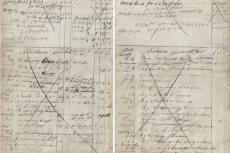Gov. Kathy Hochul announced in Montauk on Friday that the State Office of Parks, Recreation, and Historic Preservation has awarded a $2.2 million forest management contract for Napeague and Hither Hills State Parks, where the invasive southern pine beetle has killed thousands of trees and sparked concern about wildfires.
The contract will focus on areas adjacent to Montauk Highway and nearby residences and trails while creating additional access for fire departments to help reduce the risk to human life or property in the event of a wildfire, Governor Hochul said at the ribbon-cutting ceremony for the Montauk Playhouse Community Center’s new aquatic center and cultural center.
Dead trees will continue to be cut and piled, and later will either be chipped, removed, or burned under an approved burn plan, depending on site conditions, according to the governor’s office. The three-year contract will start on Nov. 1 and end Oct. 31, 2028. To comply with the Endangered Species Act, tree cutting will occur from December through February, while the federally and state-endangered northern long-eared bats hibernate in their overwintering roosts off site.
The governor received a rousing welcome as she entered the second-story cultural center at the Montauk Playhouse, built by Carl Fisher and opened in 1929. She was joined by officials including State Assemblyman Tommy John Schiavoni, former Assemblyman Fred W. Thiele Jr., Suffolk County Legislator Ann Welker, East Hampton Town Supervisor Kathee Burke-Gonzalez and her colleagues on the town board, and former supervisors Peter Van Scoyoc and Larry Cantwell.
“It’s frightening, and this is happening more and more throughout our country,” the governor said of wildfires. “The people are so worried about this spreading to their homes and businesses, and this could have gone everywhere,” she said in apparent reference to the July 16 fire on Napeague that the chief of the Amagansett Fire Department said could have been much worse. “Look what happened in Los Angeles. Right around that time, people saw those images, and they’re terrified they’re going to lose our beautiful communities.”
“We’ve got to protect our state parks,” the governor told the gathering. “And also, we’re going to have staffing around the clock during these dry seasons. It’s that early warning. If you catch it early enough, you might be able to prevent countless acres of devastation.”
The southern pine beetle infestation has ravaged the pine barrens ecosystem. One impact of the forest of dead trees in each state park has been decreased access for responders in the event of a wildfire. Strategic forest management of Long Island’s pine barrens — including thinning, brush reduction, and prescribed burning — improves forest health, reduces fuel loads, manages for the impacts from southern pine beetle risk, and restores the fire-adapted conditions on which these ecosystems depend.
Friday’s announcement came five months after a large, wind-whipped brush fire that started in Westhampton Beach and shut down Sunrise Highway in both directions before being contained. It also followed a February public meeting hosted by State Parks, Recreation, and Historic Preservation officials at Montauk Downs State Park, where reduction and mitigation of threats to public safety, protection and promotion of rare and vulnerable species and natural communities, and strengthening of ecosystem resilience to pests and disease were listed as goals for southern pine beetle management.
The invasive species was discovered in the town in the autumn of 2021 and “crashed over our parks like a tidal wave in this area,” Ron Rausch, the Parks Department’s deputy commissioner of environmental stewardship, said at that meeting. An estimated 40,000 trees were killed “within just a couple years,” said Becky Sibner, the department’s forest health specialist.
An initial effort to squelch the beetle’s spread was unsuccessful. The state’s effort then shifted to response: protection of public health and safety, and then of the natural system and ecological health.
The infestation is a manifestation of climate change, officials said, the southern pine beetle having expanded its geographic range because of warmer winters.
A tree will die within two to four months of a beetle entering it. The beetles “also have multiple generations per year, and each generation is exponentially expanding outward — climate change is a real factor here, too,” Ms. Sibner said in February. “Warmer summers allow for more generations.” Infestation can spread at a rate of 120 feet per day, she said.
In 2022, the Parks Department and the State Department of Environmental Conservation conducted “suppression cuts” in an effort to stop the infestation’s spread, felling every affected tree as well as a buffer outward. Long-term planning began in 2023, when the State Department of Transportation began cutting trees along Montauk Highway, and the Parks Department installed 25-foot-wide fuel breaks where the pine forest meets residential areas. Trees within 10 feet of either side of Paumanok Path and Promised Land trails in Napeague State Park were felled in 2024. Shrubs were also cut back to reduce the chance of a ground fire reaching the tree canopy while also opening access and visibility.
Work taking place this summer includes creating a hazard and risk analysis and fire management plan for Napeague and Hither Hills State Parks and prescribed burn plans for designated units, as well as piling of felled trees to improve trail safety for hikers along a 2.3-mile stretch of the Paumanok Path. These plans are to be completed by November. A 24-hour-a-day fire watch patrol is intended to ensure any fire outbreaks are reported promptly.




